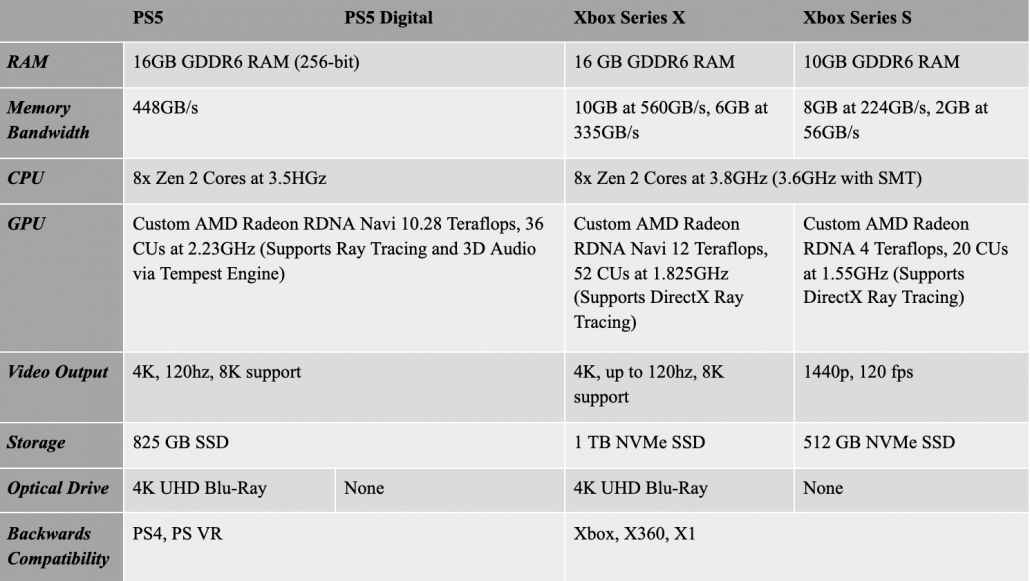The next generation of gaming: A preview of the Xbox Series X and PlayStation 5
The road to the Xbox Series X and PlayStation 5 has been a wild one, to say the least. Coming off the monumental success of the PS4, Sony is the current market leader, while Microsoft is the “underdog.” This fall, both companies will stake their claim in the next-gen race. With all their cards finally laid out, it’s time to preview the different consumers’ options.
Strategy
In terms of strategy, PS5 is continuing its focus on epic first-party titles while Microsoft is banking on consumer-friendly services, rather than just hardware.
For the first time, both tech giants are releasing multiple console models. Sony is selling two PS5 models that will release Nov. 12 in the United States: the “base” model ($499) with a physical 4K UHD (ultra-high definition) disc drive and the “digital” model ($399) without a drive. Besides the optical drive, both PS5 variants have identical specs.
Microsoft also offers two consoles, but its models vary in power. On Nov. 10, Microsoft will release its own two consoles: a higher-end Xbox Series X ($499) and lower-end Xbox Series S ($299). While both are branded “next-gen,” the Series X is the true powerhouse, with the Series S lagging in specs and lacking a disc drive.
Specs

Out of the four “next-gen” consoles, the Series S is the weakest link. Despite a great CPU, it cannot produce 4K gaming or even approach the other next-gen models’ graphical fidelity. However, both Xbox models provide robust backward compatibility.
Both the PS5 and the Series X bring 4K gaming at 120 fps to consoles and even support 8K. However, Series X has a small advantage with its 12 teraflops of GPU (graphics processing unit) compared to PS5’s 10.28. That difference will result in a slightly higher graphical fidelity, making Series X the most powerful console. However, Sony’s partnership with Unreal Engine 5, a next-gen graphics engine, possibly makes up that difference.
Services
For years, Microsoft has been praised for its services. Now, the company’s big plan moving forward is its game subscription service, Xbox Game Pass. Costing a mere $9.99 per month, it offers an incredible slate of downloadable games for Xbox and PC — it’s the Netflix of gaming.
Including blockbusters such as “The Outer Worlds” and “The Witcher 3: Wild Hunt,” Game Pass also adds Microsoft first-party studios’ games on day one. With next-generation games becoming even more expensive ($70 launch prices), Game Pass is the most economical deal in gaming.
Against Microsoft’s formidable consumer options, Sony’s services falter. PS Plus is solid but not as secure as Xbox Live. PS Now, Sony’s subscription platform, does not provide first-party titles on day one, boasting a less impressive catalogue. Gamers cannot download titles either, needing a secure Internet connection to stream.
Launch line-up
Third-party titles like “Assassin’s Creed: Valhalla” and “NBA 2K21” will be available for both consoles at launch.
In terms of first-party exclusive games, Sony easily blows Microsoft out of the water. After “Halo: Infinite’s” — well, infinite — delay, Series X lacks any big launch games but promises upscaled performances for previous titles. In contrast, PS5 boasts anticipated games right at launch: “Demon’s Souls” and “Spider-Man: Miles Morales,” among others.
Without a doubt, Sony has established itself as the king of exclusive narrative experiences this past generation. So, PS5 will continue popular franchises while bringing new ones from world-class developers. But the future is promising for Xbox; Microsoft recently acquired many talented developers, including the legendary Bethesda, so this could level the playing field, but it may take years.
Final verdict
So, which console should gamers buy this fall? Well, the answer is complicated — it depends on the gamer. While it may be more affordable for consumers to get the Series S, the console will soon be dated. On Microsoft’s advantage, Game Pass offers families an economical option — whether it’s on current-gen, next-gen or even PC.
However, the PS5 digital edition will be the best value for a truly “next-gen” console. Unlike the Series S, it’s on par with next-gen specs and still priced $100 cheaper than both the Series X and PS5 base. And Sony’s exclusive content is unparalleled, which may be the ultimate deciding factor.
With all that said, there isn’t a massive need to get either of these consoles right now. All launch games will be available across current-gen. It will take another year, at least, for games to become exclusive to new hardware. And with the pre-order craze, there may not be many consoles left in stock. The smartest option may be to save up for a next-gen console sometime next year.

